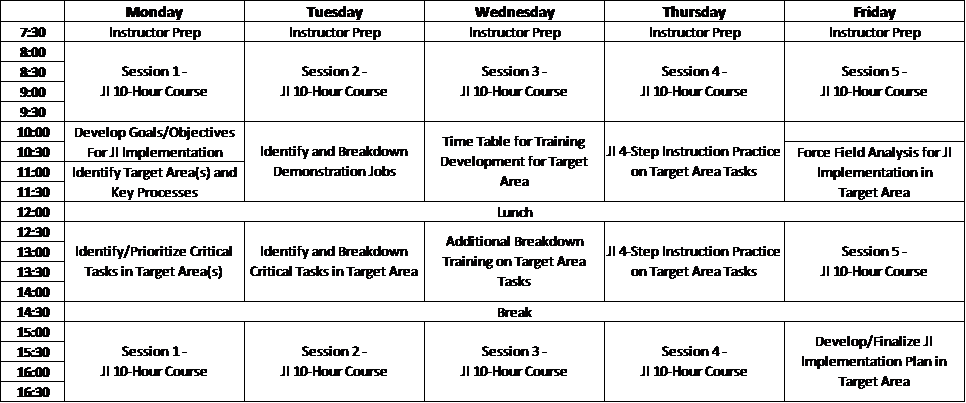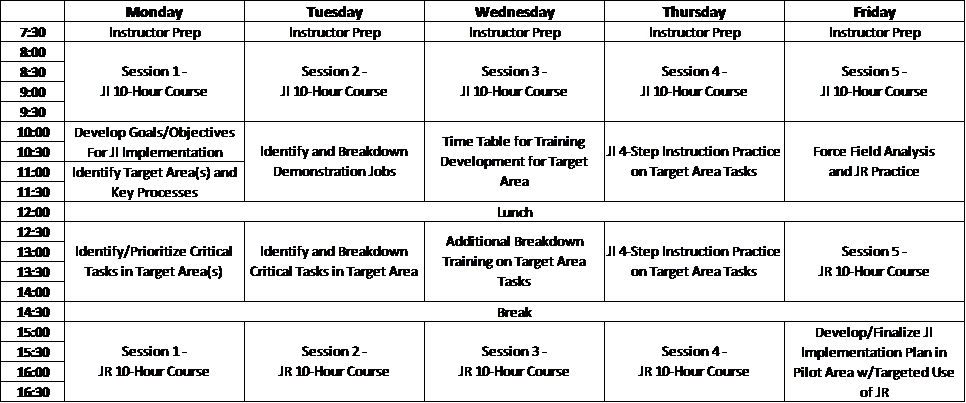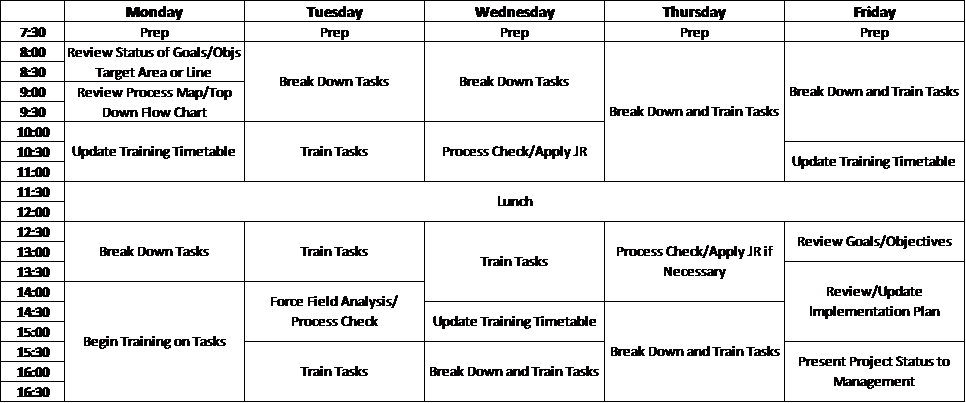In our previous posts we discussed which TWI J-program to start with (we recommended JI or JI and JR, concurrently), where and how to focus your efforts in a target area, and who to select for the training. In this installment we’ll talk about the scheduling options for your JI workshops. If you are starting out with only JI, one of the best scheduling options is to have a JI workshop first thing in the morning and another one late in the day. Our preference is to try to maintain natural workgroup integrity. You’ll be able to have between 6-10 participants and up to 10 observers in each workshop (Participants are required to give a demonstration and are involved in the discussions. Observers do not participate in discussions and do not do a demonstration in the sessions.) If we were working in a manufacturing environment, we may have the team members from the target production area in the morning session. They come in fresh, and get the training complete before the distractions of the day build up and prevent them from attending the training. In the afternoon session you could complete training of the target area team members, and include any support function people that would find the training useful, or would need to know the techniques to support the target area (Often engineering and quality must provide support to the area with modifications of Work Instructions and Standard Operating Procedures as improvements are identified in the job breakdown process.) With two workshops you create a critical mass of people who will know the Job Instruction method. If there are open slots, you can fill both sessions with additional participants and observers, which only reinforces the number people who know and can support the process.
In between sessions is a good time to schedule additional coaching in JI breakdowns and use of the 4-step JI method. Breaking down a job and using the 4-step method are not natural occurring skills and will require practice and coaching to master. Normally there are a handful of people – between 2 to 4 – who are the ‘go-to’ trainers in a target area. These people are excellent candidates for additional training can coaching. Or you may want someone who is selected to be the JI expert for the organization to receive additional practice and coaching beyond the 10-hour workshop so they can mentor the trainers after the workshop ends. Coaching, either one-on-one or in small groups, is essential to building self-confidence in the instructors’ skills and confidence in the power of the JI techniques.
In the time between workshops we also schedule time on Day 1 to review the goals for the target area and create a high level process map/top down flow chart which then guides our selection of critical tasks for creating a training timetable. Later in the week we’ll draw on the process map and critical tasks list to develop a training timetable for the target area. The timetable is our reoadmap for implementing JI training in the target area. We’ll also conduct a force field analysis which helps identify and brainstorm solutions for problems that we anticipate from implementing this new training method. Below is a typical schedule for holding two JI workshops in a week.
A Typical Schedule for Holding Two JI Workshops in a Week
Not all participants are involved in all the activities. The minimum involvement is two hours per day to attend one of the two workshops. On day one, developing the goals may involve only the leaders of the target area, their sponsor, and the 2-4 trainers that will do the bulk of the training in the area. As we move through the week, the individual or small group coaching will involve on those individuals receiving the coaching. Everyone else will be able to continue to do their jobs. This reduces the burden on the target area to provide coverage of those in the training. Often times the coaching can be done while the person is doing their job.
JI and JR Concurrent Sessions
As you might recall from Part 1 of this series, we recommended holding a JI and a JR session concurrently, if you anticipated that the JI implementation might be met with resistance. The JR workshop will give the participants the skills to handle any problems that might arise from using the JI instruction tools. In this scenario, we still recommend holding the JI session the first thing in the day with the target area folks. The participants should be the leaders, trainers, and experts in the target area and then fill any remaining slots with managers and other interested individuals. We’ve found it best to have the JR sessions in the afternoon since they are require less preparation and are less taxing than the JI sessions.
Again, between the sessions you can schedule additional practice and coaching on both the JI and JR techniques building skill and confidence in a few primary trainers or leaders. Below is a sample Schedule for a week containing both a JI and JR workshop.
Typical Schedule for Holding JI and JR Workshops Concurrently in a Week
A Second Week of Coaching
Many organizations identify a project champion that will lead JI implementation and support the trainers as they hone their skills. If you cannot provide that person, we recommend a second week of training and coaching that will help refine and stabilize the skills of the instructors and establish the implementation plan that should lead to measurable results by the end of the second week. After reviewing the goals and objectives of the plan, and making sure the critical tasks have been identified and included in the training timetable, the 2-4 primary JI instructors are giving the time and coaching to practice their breakdown and training skills with people in the area. You’ll notice on the schedule below that breakdown practice alternates with 4-step instruction practice. The best way to know if you’ve made a good breakdown is to use it for instruction. How well the learner is able to do the job is not only a reflection on your 4-step instruction skills, but provides valuable feedback on your breakdown. Were the important steps in the correct sequence? Did you have all the key points? Did the instruction flow? Could the learner do the job? By instructing using the breakdown, you’ll see how to improve that breakdown, which will make your next one better, too.
We’ve included several process checks in the schedule. These are times for the trainers to get together to discuss what they are seeing, feeling and learning. They can discuss the issues they’ve experienced and what solutions they’ve tried. In these sessions, best practices for applying and implementing JI are developed. If you’ve combined JI/JR workshops in the week, the process checks can also be times were application of the JR process can be discussed. A sample second week of practice and coaching is below.
A Second Week of Guided Practice and Coaching
These are just sample schedules and your needs may require modifications or a whole new schedule. In the past we’ve successfully presented the training in a compressed three day period, and also over a two week period. The key to scheduling is that the sessions do require some spacing, because the participants will have to prepare demonstrations outside of the sessions. Additionally, they should be run no more than a week or two. If the training drags out longer than two weeks, participants will begin to forget what they’ve learned before they even complete the training. We also have additional schedules that we’ve developed that are for training your own 10-hour JI course trainers.
This installment of our series on implementing TWI, presented several options for scheduling your initial training. Though there are several principles – five 2-hour sessions, spacing between the sessions, completing the all five sessions within two weeks – the scheduling can be quite flexible to meet your training needs without sacrificing you meeting your customers’ needs. Feel free to call or e-mail us if you would like to explore how this might be accomplished for you own unique situation.
Our next installment will cover Conducting the JI Workshop.



